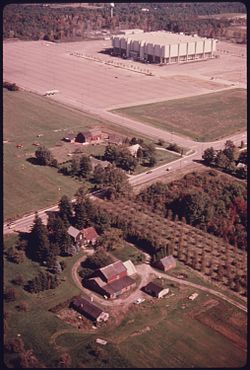This article needs additional citations for verification .(January 2024) |
The Palace on the Prairie [1] | |
 | |
 Aerial view of the Coliseum and neighboring farms in 1975 | |
 | |
| Address | 2923 Streetsboro Road |
|---|---|
| Location | Richfield Township, Ohio |
| Coordinates | 41°14′43″N81°35′38″W / 41.24528°N 81.59389°W |
| Owner | Gund Business Enterprises, Inc. |
| Operator | Gund Business Enterprises, Inc. |
| Capacity | Basketball: 20,273 Ice hockey: 18,544 |
| Construction | |
| Broke ground | March 16, 1973 |
| Opened | October 26, 1974 [2] |
| Closed | September 24, 1994 [2] |
| Demolished | March–May 1999 |
| Construction cost | US$36 million [2] ($247 million in 2023 dollars [3] ) |
| Architect | George E. Ross Architects, Inc. [4] |
| Tenants | |
| Cleveland Crusaders (WHA) (1974–1976) Cleveland Cavaliers (NBA) (1974–1994) Cleveland Nets (WTT) (1975–1977) Cleveland Barons (NHL) (1976–1978) Cleveland Force (MISL) (1978–1988) Cleveland Crunch (MISL) (1989–1992) Cleveland Lumberjacks (IHL) (1992–1994) Cleveland Thunderbolts (AFL) (1992–1994) | |
Richfield Coliseum, also known as the Coliseum at Richfield, was an indoor arena located in Richfield Township, between Cleveland and Akron, Ohio. It opened in 1974 as a replacement for the Cleveland Arena, and had a seating capacity of 20,273 for basketball. It was the main arena for the Northeast Ohio region until 1994, when it was replaced by Gund Arena (now Rocket Arena) in downtown Cleveland. The Coliseum stood vacant for five years before it was purchased and demolished in 1999 by the National Park Service. The site of the building was converted to a meadow and is now part of Cuyahoga Valley National Park.
Contents
- History
- Attendance hindrances
- Demolition and environmental remediation
- Seating capacity
- References
- External links
The arena was primarily the home to the Cleveland Cavaliers of the National Basketball Association (NBA), developed by Cavaliers owner Nick Mileti, who also owned the Cleveland Crusaders of the World Hockey Association. Over the years it had additional tenants such as the Cleveland Barons of the National Hockey League, Cleveland Force of Major Indoor Soccer League, Cleveland Crunch of Major Indoor Soccer League, the Cleveland Lumberjacks of the International Hockey League, and the Cleveland Thunderbolts of the Arena Football League.
It hosted the 1981 NBA All-Star Game; The Buckeye Homecoming, the 1983 professional boxing match between Michael Dokes and Gerrie Coetzee; and the 1985 MISL All Star Game. It was also the site of the March 24, 1975 boxing match between Muhammad Ali and Chuck Wepner, which in part inspired the movie Rocky . [5]
The Coliseum was a regular concert venue, with its first event being a concert by Frank Sinatra. The first rock concert at the Richfield Coliseum, in October 1974, featured Stevie Wonder in October 1974. [6] The last concert was by Roger Daltrey, in 1994; that was also the last official event at the arena. [7]